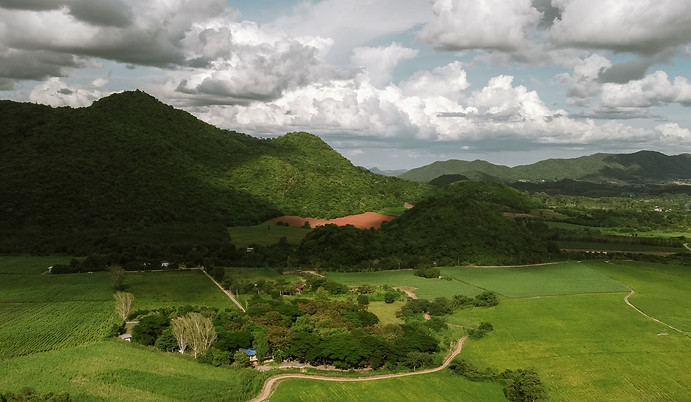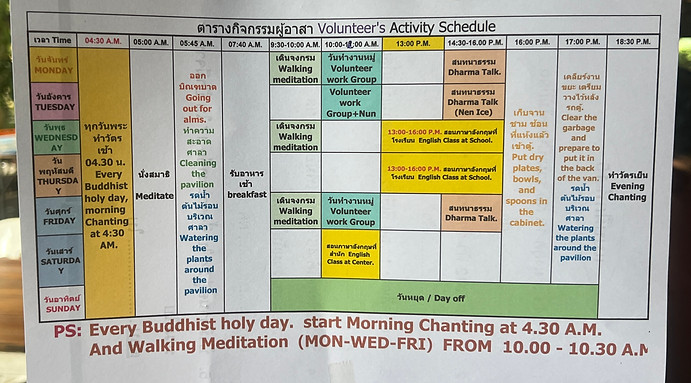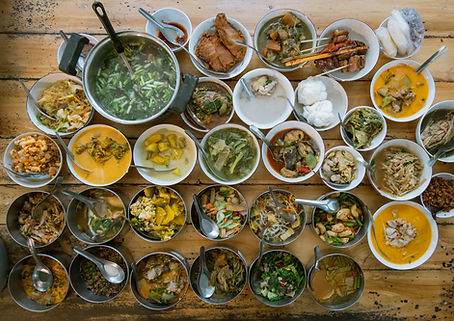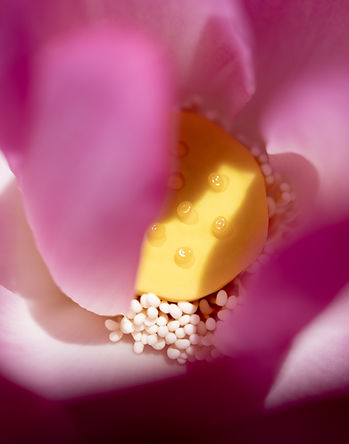Claire Thomas Photography
Living with Bhikkhuni Nuns in Thailand
Introduction
When I began browsing Workaway for hosts during my travels throughout Asia, I knew I wanted to apply for this one:

Before arriving, I coordinated with the head nun, Luangmae, a fluent English speaker who once worked as an architect in the USA before opening the Dhamma centre in 2009. Although I’d never thoroughly explored Buddhism before, I’ve always been drawn to experiences that support self-betterment. I deal with anxiety, which can make it hard for me to stay present at times. This unique Workaway host (filled with overwhelmingly positive reviews from previous volunteers) stood out as a beautiful opportunity to learn, connect inward, and develop a stronger sense of inner peace.

The Vijjaram Dhamma Center is located in a small village in the Ban Rai District of Uthai Thani, about 3.5 hours northwest of Bangkok. The centre teaches Theravada Buddhism, the dominant tradition in Thailand, and is run by Bhikkhuni nuns—ordained female monks. There are very few Bhikkhunis in Thailand, and they are not officially recognized or funded by the Thai government. Because of this, they rely on volunteer support and welcome international volunteers to help in exchange for learning traditional Theravada Buddhism in English, along with accommodation and meals.
Living alongside these women felt incredibly meaningful. It was powerful to support a community that continues its practice despite structural challenges.


Daily life

Our days started early. We woke up around 4:30am and gathered in the meditation hall by 5am. As intense as that sounds, I adjusted quickly and learned to appreciate the natural rhythm of waking and sleeping with the sun.
After 30 minutes of meditation, volunteers split into two groups: half stayed behind to clean the main hall, while the other half joined the nuns for alms rounds. Alms is a central Buddhist practice. Each day, the nuns walk the same route through the village to collect food donations from local laypeople—those who practice Buddhism while living everyday lives. This daily ritual is an interdependent relationship: the nuns depend on laypeople for food, and the laypeople receive merit and spiritual encouragement by giving.
The poverty of the village was clear during our walks. Despite this, the laypeople were always happy to donate food to the nuns, offering it with warm smiles and blessings.




At first while assisting with the alms, I felt completely out of place. The practice felt sacred, and I didn’t yet understand the full scope of Buddhist customs. But the nuns rely on volunteers to carry their food bags and were always kind and grateful for our help. It became an honour to support them in such a vital part of their day.
Once we got back, the other volunteers and I laid out the food offerings on long tables—there was always a big variety, including curries, fruit, and sweets. After preparing the food, we would head outside to sweep up fallen leaves for about 30 minutes. There were always leaves to be swept!


We’d then eat around 8am. The nuns ate first, following a short chant, and then we were free to serve ourselves. We served ourselves modest portions, mindful not to take more than we needed and to avoid waste.
The nuns only eat twice a day—breakfast and lunch—and don’t eat anything after 12pm. They also cannot store food for the next day, which is why the daily connection with the local community is so important.
After we finished eating, the volunteers packed up our lunches, the leftovers, cleaned the area, and washed the dishes. A local man who lived nearby would then come by on his motorbike, pick up the food, and deliver it to those in need. It was wonderful to know that the food was always shared, creating a chain of generosity and deep community.


The rest of the day varied day by day.
3 days a week: we had walking meditation (explained more below).
3 days a week: we did physical volunteer work, like repairing huts, planting grass, fixing flooding issues, or washing the alms van. It was humid and intense, but rewarding.



2 days a week: we taught English to local Thai children. It was chaotic at times, especially with the older kids, but meaningful to support a community that otherwise couldn’t afford English teachers.
2 days a week: we had Dhamma or Sutta talks with the nuns. Dhamma talks were open Q&A-style sessions where we could bring questions and dive deeper into the teachings. Sutta talks involve reading and discussing Buddhist texts, finding ways to apply their messages to our lives. These sessions helped ground me when I felt disconnected. Luangmae always made herself available for one-on-one chats, which I really appreciated.

1 day a week: We had a day off (besides morning/evening meditation and alms)! The volunteers were free to take the spare van and explore the area. We went to nearby waterfalls, temples, and local markets.
We ended each day at 6:30pm with evening chanting and meditation. The chanting helped reinforce Buddhist principles, and the 30-minute meditation afterward brought the day to a peaceful close.


Meditation
We practiced two main types of meditation:
Concentration meditation (morning & evening):
This involved focusing on the breath to quiet the mind. It was/is hard—sitting for 30 minutes without letting your thoughts run wild takes a lot of practice. But just like a muscle, the mind strengthens over time. The goal isn’t not to think, but to notice when your mind wanders, and gently bring your focus back to the breath.
Mindfulness (walking) meditation:
We would walk slowly back and forth for about 20 paces, paying attention to what came up—whether body sensations, emotions, thoughts, or awareness of Dhamma (which loosely means the truth of how things are). You’re not trying to control your thoughts, just observe where your attention naturally flows. When you notice yourself spiraling into one thought, you gently return to observing again. This practice is difficult but can lead to long-term positive change in our relationships with our minds. It trains your brain to be less reactive, and over time, helps negative thoughts pass more quickly.

Core Ideas of Buddhism
Before this trip, I never imagined aligning with a religion. But Buddhism doesn’t really fit into the typical “religion” category. There’s no god to worship—but a deep respect for a teacher (the Buddha) who found peace and shared his path to enlightenment. It’s also not forced- each person chooses to walk the path at their own pace.
Key teachings:
Suffering is inevitable. Most suffering comes from attachment—we get used to something (a feeling, person, or comfort), and we suffer when it changes or disappears.
Impermanence is at the heart of this. Everything is always changing, and resisting that change only deepens our suffering.
At first, these ideas may sound pessimistic. But Buddhism isn’t about avoiding joy—it’s about letting go of clinging. You can embrace and enjoy beautiful moments, but without expecting them to last forever. It’s also not about avoiding negative emotions. Burying pain or pretending it doesn’t exist is unhealthy. Instead, Buddhism teaches us to notice our difficult thoughts and feelings, acknowledge them, and then let them pass without giving them power. This perspective reminds us that pain is also temporary.
Another key idea is no-self, or anatta—the understanding that there’s no fixed, unchanging “me.” Our thoughts, feelings, and identities are always shifting, and attaching to a solid sense of self can create even more suffering. Letting go of that illusion can help us take things less personally and move through life with greater ease.
Buddhism is incredibly relevant to everyday life. I found these concepts especially powerful when applied to my own experiences. For example, forgiveness. We often hold onto pain caused by people who have wronged us. Forgiving isn’t about excusing them—it’s about freeing ourselves from a past narrative. Also, alongside the concept of impermanence, the past no longer exists except as memory; only the present moment is real.
We can also consciously act opposite to our instincts, sending feelings of love and joy even toward those who have hurt us. Doing so creates lightness within and gradually replaces negative emotions with kindness and compassion.
These concepts have inspired me greatly, but of course, applying them is very much a work in progress. Detachment doesn’t come easily. Sometimes, simply recognizing that we’re attached is a step forward. That awareness can prepare us for the moment when the attachment inevitably brings pain—and help us meet it with acceptance.



Accomodation
While the photos I took capture a lot of the beauty of the experience, there were also plenty of less-photogenic aspects that aren’t shown. The rooms were very small and basic—just the essentials. The beds were firm (very firm!), but I got used to them quickly. There were quite a few spiders and geckos in the rooms, which was a challenge for some of the volunteers. The bathrooms were definitely bare-bones: the shower head was placed in the middle of the bathroom, so you would have to sweep water toward the drain after each use.
That said, it was everything I really needed. I was grateful to have my own space. The simplicity of the environment actually added to the experience, helping me let go of unnecessary comforts and focus on what mattered.

Taking Silence
The centre also offered 3 or 5-day silent retreats. You still joined meditation and alms, but were excused from other duties and social interactions. I opted to do 3 days of silence. Being alone with my thoughts helped me notice the ones I give the most energy to—and which ones don’t really serve me. It was interesting to be around people who were conversing and exist as an observer. I found that when social issues arose around me, they'd often fix themselves over time without any intervention, which was an interesting insight. I honestly did not experience any grand revelations, and that’s okay. The point is to observe and not to expect a specific outcome from the experience.
Photography & Videography
When I arrived, I intended to take a break from photography. I wasn’t sure if it would be appropriate to document the centre or the nuns, since their practice doesn’t focus on ego or image. But after a week and a half or so, I got to urge to capture some of the animals on site, and the centre from above with my drone.



When I showed Luangmae, she was really excited—and later, the nuns asked me to document more. They also were in need of a video to summarize the centre, and I offered to make it for them. You can find the video at the bottom of the page.
It meant a lot to contribute in this way and reminded me how much joy it gives me to share my creative skills to help others.
Final Thoughts
I’m so thankful for this experience. I recognize the great privilege I have in being able to travel and to be welcomed into their spiritual community. I've always wanted to work on myself, but didn’t know where to begin. Now, I feel like I have a clearer path and an eagerness to continue learning.
A great deal of our suffering is born or amplified in the mind. A lot of what we cling to is not truly ours. When we're in a dark place, we tend to feel isolated and feel like our pain is unique- no one could possibly understand. Understanding that suffering is part of the shared human experience has given me the space to better observe it without being consumed by it.
I've been reflecting on the inspiration I found in Ban Rai, where generosity is deeply woven into Thai culture through Buddhism. Being immersed in that mindset, and seeing it in action, was incredibly moving. Western culture tends to place a stronger emphasis on individualism, and it was deeply fulfilling to be part of a system of living so rooted in collective care. It has since made me think about how I can build my future life and career in a way that allows me to positively impact those around me.

I'm so appreciative of the people I met through this experience. Living so closely with the other volunteers meant we got to know each other on a deeper level. It was something special to form friendships in an environment like this—and to witness their growth along the way.
I'm also deeply grateful for the nuns, who taught me so much. They showed endless kindness and always made time for the volunteers. Any idea I had that Buddhism might be pessimistic is gone. The nuns were always laughing and living in the present moment.

Am I a Buddhist now? I’m not sure- labels are weird. But I do know that Buddhist teachings are grounded in real life, applicable, and beneficial. I want to keep learning, make new discoveries, and maintain a meditation practice. It's been a month now since I left- I haven't meditated every day, but that’s okay. When I left the centre, one of the nuns reminded me:
"Be kind to yourself. If you miss a day, it’s okay. Meditation isn’t meant to cause suffering. These practices are always here for you, no matter what stage of life you’re in. You can always come back to it."
If you’re curious about Buddhism, want to chat, or share your own experience—feel free to reach out. I’m not an expert, but I’ve found these conversations really meaningful. My email address can be found at the bottom of my website.
Watch the video in HD quality!
Educational Resources:
Thailand Foundation -
This was the book they encouraged all volunteers to read. It explains concepts very simply. Strongly recommend!
Jay Shetty -
I recommend the audiobook on Audible. It presents Buddhist-inspired ideas in a Western context and offers thoughtful questions for personal reflection. He's presents ideas in ways that are easy to understand, and reads in a very engaging way.
Thich Nhat Hanh -
All photos and videos © Claire Thomas. Please do not use without permission.














